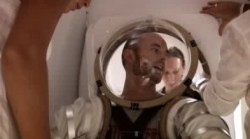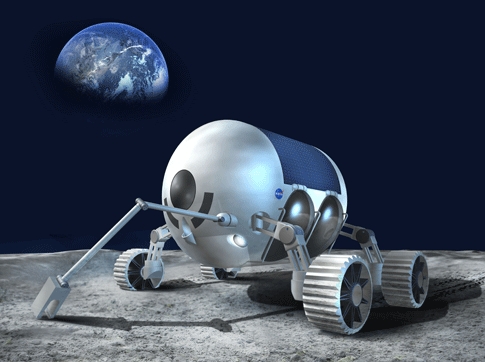[/caption]
Last year, students from Rhode Island School of Design (RISD) were set one of the best coursework projects I’ve ever heard of. The project title was called “Design for extreme environments” and it was sponsored by NASA. By extreme environments, we are talking about the Moon, and by design, we are talking about arriving at new concepts as to how to prevent lunar dust contamination inside future lunar habitats. Since the task was first set, the enthusiastic RSID team have arrived at a concept that NASA will be using in the planning of the 2020 return to the lunar surface…
The Moon is a dirty place. During the Apollo missions, dust from the lunar surface got everywhere. The biggest problem for astronauts came when the tiny, sharp shards of regolith (pulverized bits of rock from billions of years of meteorite impacts) was disturbed by the moon buggy as the lunar explorers travelled across the dusty surface. One event in particular stands out as the problems lunar dust can cause. In 1972, Apollo 17 astronauts Gene Cernan and Jack Schmitt had accidentally damaged the wheel arch of their moon buggy. The result was a dreaded “rooster tail” was they drove, kicking up dust into the vacuum, causing it to cover everything, including spacesuit visors. This would lead to vision impairment, scratches of the protective visor coating and ultimately respiratory problems when transported inside the lunar module (“LEM”). Fortunately Cernan and Schmitt managed to repair their moon buggy with a roll of duct tape, possibly saving the lunar surface mission.

Moon dust contamination was inevitable however, even inside the sealed LEM. So, with the possibility of extended manned exploration of the Moon and Mars from the year 2020, NASA is re-evaluating the challenges astronauts will face when combating this potentially dangerous foe. Many scientists are especially worried about the health of manned settlements should lunar dust be allowed into habitats. Breathing the stuff in could be as dangerous as breathing in asbestos. When working with the dusty cancer-causing material down here on Earth, specialist breathing apparatus must be worn at all times. If this were to be the case on the Moon, to fight the health risks associated with breathing in moon dust, short-term and long-term damage could be inflicted on the young colony.
This is where the RISD project comes in. In preparation for a possible manned return to the Moon in just over a decade, NASA decided to tap into the ingenuity of students from the design school to arrive at some novel ideas as to how eliminate the risk of letting lunar dust into a future moon buggy. Several design and engineering students and graduates from RISD’s Industrial Design Department took part in a RISD/NASA research internship focusing on elements of a future lunar module – the descent stage, habitat and ascent stage. The 2007 summer internship focused on the dust problem.

The students investigated a “suitlock” design, an airlock that uses the astronauts’ space suits as part of the operation to remove any contaminants. To make access to the lunar surface quick and routine, the research focused on using an existing rear-entry space suit that would be stored inside an air- and dust-tight seal, but the astronauts would be able to slide into the suit whilst keeping the suit itself separate from the habitat interior. To see how the RISD concept works, view the full-scale mock-up video of the demonstration session.
The RISD concept was taken from paper and consolidated into a full-scale rigid mock up. The design can now be evaluated by NASA for possible inclusion in the future exploration of the Moon. This project for the RISD interns is obviously a valuable experience for the students taking their vision and turning it into a “real-world” application, but NASA has the chance to learn from the fertile imaginations of design and engineering graduates, possibly taking the exploration of space in an unexpected but advantageous direction…
Sources: RISD, Popular Science


NASA Reaches Out to Design Students
At last someone’s tackling the problem of poorly-designed students.
I propose a charged static field for men and machine, if the dust particles are also charged on the point of disturbance they will be repelled, collectors with an opposite charge should cut down the suspended dust particles in general and after a hard day at work, beer to wash it all down.
@Vagueofgodalming:
That is too funny – damn those poorly-designed students. It’s about time NASA reaches out to engineer students too… 😉
@Greenmistress:
Thank you for your honesty. If our newsletter is becoming a problem for you, I have to question your lack of common sense. Why have you remained a subscriber for so long? There are plenty of other space blogs out there, why not sign up to them? Could it be that you actually enjoy the articles we produce? Try finding the above article on any other space news blog, I doubt you’ll find any other site with such a diverse mix of subjects.
I admit, I was a little sloppy during the writeup of the article and have since corrected some grammatical errors. However, if you spend so much time on the site, you’ll see our readers have a major influence in the topics we write about and the accuracy of our text. Next time, please indicate where your annoyance is and we’ll do our best to correct it, rather than just complaining about a mystery “10 errors.”
Keep in mind, this is a space news blog, this is not New Scientist. Our scientific content is just as good, better even (our writers are all professionals in their scientific field), but during publication we don’t have to go through the delay of waiting for our editor to proof-read text. Obviously mistakes will happen in this case, but at least the news is published ASAP often beating the competition.
As for my “awkward” writing style, that I can’t help, but hey, at least there are other writers for the UT who might fit your criteria a little better.
Thanks, Ian 🙂
@Sili:
Thank you for your support 🙂 Always appreciated.
Cheers! Ian 😀
I have been getting your email updates for about a year now, and I’m totally fed up with all the grammar and spelling mistakes and the awkward sentence structure that frequently pops up in your articles. I counted at least 10 mistakes in this article alone. Where is your editor?! Don’t your journalists proofread their articles?! Where is the accountability? I’m not the best speller in the world, and I’ve been accused of overusing commas more times than I can count, but then I don’t put out a daily newsletter either. When your grammar mistakes make your material hard to read, your mistakes have stopped being a nuisance, and have become a problem. Please be more careful in the future about proofreading and editing. Your content is usually so good it shouldn’t be destroyed by your lack of diligence concerning grammar, spelling, and sentence structure.
Pave the moon.
aw the dust hoax
Melt the water at the polar regions and spray it on the ground at the landing site, just like dust control on construction sites. lol Or do like humans have done for all of our history send some underprivileged grunts up to do the dirty work and leave them there while the “officers” do all the thinking.
cynic ext.
Oh, whine a bit more, Greenmistress, why don’t you.
I sincerely doubt that out esteemed hosts are paid to write this blog. Nor are they professional journalists (correct me if I’m wrong).
If you can’t handle the typos (I rarely notice any – if you want examples of poor writing, let me know and I’ll point you in the right direction). Or fix the ‘problem’, yourself. Copy the post into your texteditor of choice and hit “Check spelling”. Problem solved!
Considering the speed with which they digest and convey the news, I think they’re doing a bang-up job. And I, for one, thank them.
Ah, for the days when we thought it was made of Swiss cheese…
GreenMissy…
If you are going to be part of the Grammar Police, at least ensure your grammar is above reproach. I stopped counting errors in your post after 10; and I didn’t count the mispelling, commas or improper uses of the word “that” (which is pretty common today). I do have to admit your double conjunction sentences do irritate me a bit.
You aren’t paying for this so back off a bit. If you can’t take it… move on!
Hi Ian,
Quite a bit of dust was blown up here 🙂
There is an error in the following sentence:
‘The result was a dreaded “rooster tail” was they drove,…
it should be ‘as’ instead of ‘was’.